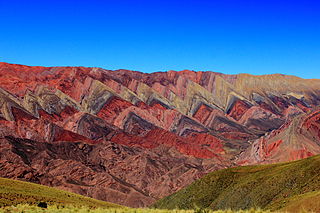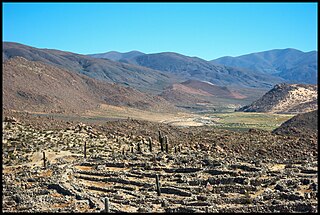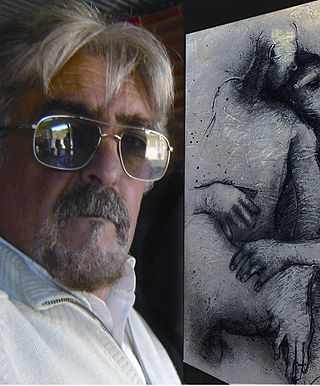Santa Rosa is the Italian, Portuguese, and Spanish name for Saint Rose.

Jujuy is a province of Argentina, located in the extreme northwest of the country, at the borders with Chile and Bolivia. The only neighboring Argentine province is Salta to the east and south.

Serpa is a city and a Concelho (municipality) in the central Portuguese region Alentejo. The population in 2011 was 15,623, in an area of 1,105.63 square kilometres (426.89 sq mi). The Guadiana River flows close to the town of Serpa.
Moisés Ville is a small town (comuna) in the province of Santa Fe, Argentina, founded on 23 October 1889 by Eastern European and Russian Jews escaping pogroms and persecution. The original name intended for the town was Kiryat Moshe honoring Baron Maurice Moshe Hirsch, but the land agent who registered the settlement translated it to the French-like Moïsesville which was later hispanized to the current Moisés Ville. The town is located about 177 km (110 mi) from the provincial capital, in the San Cristóbal Department and 616 km (383 mi) from Buenos Aires. It had 2,425 inhabitants at the 2010 census [INDEC].

Departments form the second level of administrative division, and are subdivided in municipalities. They are extended in all of Argentina except for the Province of Buenos Aires and the Autonomous City of Buenos Aires, the national capital, each of which has different administrative arrangements.

Cachi is a small city in Salta Province Argentina. It is the capital of the Cachi Department.

Santa Rosa de Ocopa is the name of a district of Concepción province, Department of Junin in Peru. It is also the name of the capital of the district, and the name of a historic monastery in the district called the Convent of Santa Rosa de Ocopa. In 2017, the district had a population of 2,129 and an area of 16.1 square kilometres (6.2 sq mi). The capital of the district, the town of Santa Rosa, had a population of 1,263 in 2017 and an elevation of 3,376 metres (11,076 ft) above sea level. The name "Ocopa" comes from the Quechua "ocupi," meaning "within" or "corner."
Santa Rosa (Salta) is a village and rural municipality in Salta Province in northwestern Argentina.
Santa Rosa de los Pastos Grandes is a village and rural municipality in Salta Province in northwestern Argentina.

Tastil is an archaeological site near Santa Rosa de Tastil, Salta Province, Argentina.

Donato Grima is an Argentine visual artist. He studied arts and design. During the 1970s, he moved to Caracas, Venezuela. He did not return to his home country until the mid 1980s, together with the restoration of democracy. From the 1990s until 2001 he lived in Spain. His painting The Patriarchs is in the collection of the Museo del Barrio of New York City. Other museums and private collections in several countries in Latin America and Europe bought part of his work. By 1993 he founded, in Argentina, The Center of Art & Design, institution devoted to the education in art and design. In 2009 he created his art gallery Art Territory in Tucumán.

Los Andes is a department located in Salta Province, Argentina. It is the second largest by area in the province, after Rivadavia Department, and its capital is the town of San Antonio de los Cobres.

The Salta–Antofagasta railway, also named Huaytiquina, is a non-electrified single track railway line that links Argentina and Chile passing through the Andes. It is a 1,000 mmmetre gauge railway with a total length of 941 km, connecting the city of Salta (Argentina) to the one of Antofagasta (Chile), on the Pacific Ocean, passing through the Puna de Atacama and Atacama Desert.

Richard Fontaine Maury was an American railway engineer and naturalized Argentine. He became known for the project of the Argentine "Ramal C-14" of the Ferrocarril General Manuel Belgrano and the touristic Tren a las Nubes.

Santa Rosa de Lima was an early 18th-century Spanish settlement in the Rio Chama valley, near the present-day town of Abiquiu in Rio Arriba County, New Mexico, United States

Rosa Tarlovsky de Roisinblit is an Argentine human rights activist who is the current vice president and founding member of the Grandmothers of the Plaza de Mayo Association. Tarlovsky was born in a rural area of the province of Santa Fe as the daughter of a farmer and rancher who suffered the consequences of the Great Depression. At the end of primary education, she moved to Rosario to study midwifery. She then worked at the Faculty of Medicine of that city until 1944.

Colegio de Santa Rosa - Manila is a private Catholic school run by the Congregation of the Augustinian Recollect Sisters in Intramuros, Manila, Philippines. It was established on August 30, 1750 as the Beaterio y Casa de Segunda Enseñanza by Mother Paula de la Santissima Trinidad to educate the young Spanish - Filipino women. It was originally an All Girls school until the early 2000 when it converted to a co-ed educational institution. It acquired its present name on 1774 but was also known by several other names including Colegio de Madre Paula and Beaterio y Casa de Enseñanza.

The Castle of Serpa is a medieval castle located in the civil parish of Serpa, in the municipality of Serpa, Portuguese district of Beja.

Gladys Rosa Moisés was an Argentine politician. A member of the Republican Proposal, she served in the Cámara de Diputados de la Provincia de Salta from 2017 to 2021 and was Executive Director of PAMI in the Salta Province from 2016 to 2017. She died of cancer in San José de Metán on 5 March 2022, at the age of 60.


















